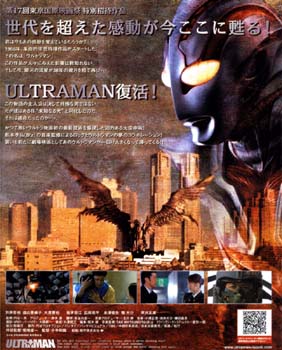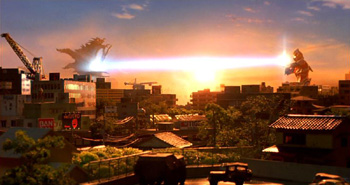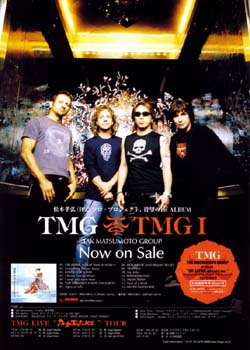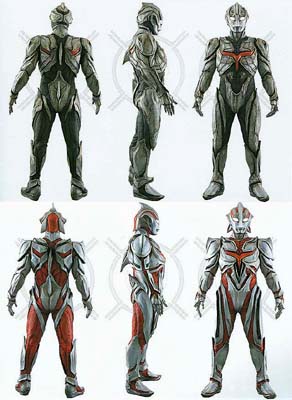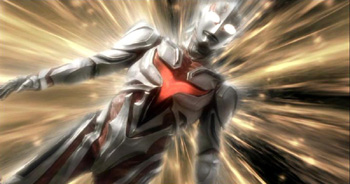 In 2004, Tsuburaya Pro took Ultraman back to the basics with the feature film ULTRAMAN: THE NEXT. Photo courtesy of Tsuburaya Productions. ©2004 ULTRAMAN Movie Production Consortium
In 2004, Tsuburaya Pro took Ultraman back to the basics with the feature film ULTRAMAN: THE NEXT. Photo courtesy of Tsuburaya Productions. ©2004 ULTRAMAN Movie Production ConsortiumA Look Back at the Popular 2004 Film with Press Notes, Interviews, and Photos from Tsuburaya Pro Source: Tsuburaya Productions Official Movie Site: Ultraman The Movie Additional Material: Brad Warner
After a trilogy of juvenile oriented films starring ULTRAMAN COSMOS (2001-2003), in 2004 Tsuburaya Productions decided the time had come for a major relaunch and revamp of their Ultra franchise. The company hoped to lure older viewers back to the fold with nostalgic and more adult-themed programming like the radio drama THE ULTRA Q CLUB (Urutora Kyuu Club), the late night TV series ULTRA Q: DARK FANTASY (Urutora Kyuu Daaku Fantajii), and the new Ultraman show ULTRAMAN NEXUS (Urutoraman Nekkusasu). For a more detailed look at these shows please see James Ballard`s article Tsuburaya Productions, 2004: A Year in Retrospect. Tsuburaya Pro wrapped up the year with ULTRAMAN: THE NEXT (Urutoraman), a new movie that opened in Japanese theaters on December 18, 2004. ULTRAMAN: THE NEXT was both a "back to the basics" approach and a grittier, more mature look at Ultraman that brought the character out of the world of fantasy and into a real world setting. The film provided a great starting point for newcomers unfamiliar with the Ultraman franchise, and particularly appealed to fans of darker kaiju movies like GAMERA 3: REVENGE OF IRIS (Gamera 3: Iris Kakusei, 1999) and GODZILLA, MOTHRA & KING GHIDORAH: GIANT MONSTERS ALL-OUT ATTACK (Gojira Mosura Kingugidora Daikaiju Soukougeki, 2001). SciFi Japan takes a look back at ULTRAMAN: THE NEXT with Tsuburaya Productions` 2005 English language press kit for the film as well as quotes from unpublished interviews with Ultraman designer Hiroshi Maruyama and special effects director Yuichi Kikuchi. The press materials have been slightly modified to bring the information more up to date.
ULTRAMAN IS BACK!
 English language international promotional art. Photo courtesy of Tsuburaya Productions. ©2004 ULTRAMAN Movie Production Consortium
English language international promotional art. Photo courtesy of Tsuburaya Productions. ©2004 ULTRAMAN Movie Production ConsortiumAll across the United States, millions of kids thrilled to the adventures of Ultraman, the 140-foot tall red and silver superhero, on TV throughout the late 1960’s to the early 80’s. Ultraman virtually vanished from the American airwaves after that. But all over Asia the show continued going strong. 2006 marked Ultraman’s 40th anniversary, with new productions almost every year during those four decades. In 2005, Ultraman made his triumphant return to America in ULTRAMAN: THE NEXT, an all-new special effects packed action adventure science fiction thriller from Tsuburaya Productions. This Ultra-fun feature returns to the roots of the Ultraman legend with a completely new take on the hero. The film was selected for the Munich Film Festival in Germany and the FantAsia Film Festival in Canada, and had its Hollywood premiere at the prestigious Egyptian Theatre on Hollywood Boulevard on June 25, 2005. In August of that year it also played in San Francisco’s historic Castro Theater as part of Bay Area Film Event`s "Ultramania" festival. All of the North American showings were attended by special guests such as Ultraman designer Hiroshi Maruyama and Brad Warner of Tsuburaya Productions, and featured incredible prize give-aways, including a limited edition Ultraman guitar manufactured by Ibanez Iceman Guitars.
SYNOPSIS
Shunichi Maki is a fighter pilot with the Japan Self Defense Forces (JSDF) on what he intends to be his final day with the JSDF. His six year old son has been diagnosed with a deadly illness. The doctors say he may have only a precious few more months to live. Maki has decided to give up his love for flying high powered jets in order to devote more time to his family.
 An early stage of “The One”, the evolving villain of ULTRAMAN: THE NEXT. ©2004 ULTRAMAN Movie Production Consortium
An early stage of “The One”, the evolving villain of ULTRAMAN: THE NEXT. ©2004 ULTRAMAN Movie Production ConsortiumBut just as he is about to turn in his uniform for the last time the order comes to scramble. A strange UFO has been sighted on a direct course for Tokyo. The government suspects this may be a missile launched from an unfriendly military power in the area. Maki’s orders are to identify the object or destroy it. But as the jets near the UFO all of the other jets in the squadron find their engines mysteriously disabled. They have no choice but to break off. Yet Maki’s jet remains unaffected. He alone continues on course. As he nears the object, Maki can just barely make out its form, a ball of glowing red plasma streaking through the upper atmosphere at phenomenal speed. A moment after he sees the object, Maki blacks out. Observers at the JSDF base watch their radar screens in horror as Maki’s jet collides with the UFO. A search party sets out immediately to recover the wreckage from a remote mountainous region of Japan. To their astonishment they find Maki not only alive, but virtually unhurt. Yet there is no evidence as to how he might have survived, not even a parachute to indicate he ejected before the crash. Maki himself has no memory of anything after he lost consciousness aboard his plane. A military tribunal is called, but as far as they can determine, Maki is telling the truth. They reluctantly allow him to leave the base to join his family on the condition that he make himself available for further interrogation.
 The Next battles the second stage of The One. Photo courtesy of Tsuburaya Productions.©2004 ULTRAMAN Movie Production Consortium
The Next battles the second stage of The One. Photo courtesy of Tsuburaya Productions.©2004 ULTRAMAN Movie Production ConsortiumMaki takes a job at a small company that gives tourists hour-long joy rides on a Cessna. It’s not like piloting fighter jets. But the steady hours mean he gets more time to be near his son. On his first day a strange woman in black, Sara Mizuhara, signs up for a ride and holds Maki at gunpoint, ordering him to fly far off his usual course. The mysterious hijacker takes him to a secret military base where Maki is quarantined in a huge concrete reinforced bunker. His demands to know why are met with stoic silence. Finally, once Maki is securely locked into the bunker’s basement under guard and unable to escape, he is told the answer. Maki was not the first to mysteriously survive a deadly crash with a mysterious UFO. Only a week earlier another soldier named Takafumi Udo experienced the very same thing. But in the previous case, after the crash soldier`s body began to undergo bizarre changes. Udo grew in size and strength, eventually mutating into a huge and powerful monster. The monster escaped from the base and is now on the loose in the Japanese countryside. Maki is now in the custody of an ultra clandestine wing of the Self Defense Forces. They have captured Maki for two reasons. First, although he shows no signs of the mutation the previous pilot suffered, they fear it’s only a matter of time. And they believe the mutated Udo is looking for Maki. In other words, they are using Maki as bait.
The first beast has been code named “The One.” “And what code name do you have for me?” Maki shouts at the woman in black. Sara hesitates for a moment, then says quietly, “The Next.” We learn that Udo was Sara’s fiancée and that Sara, a specialist in chemical weaponry, may be the one person who holds the key to his destruction. The monster soon makes its appearance. But now it has grown even larger and more powerful than before. The reptilian alien beast towers nearly ten meters (30 feet) tall. Its massive snake-like tail can be used as a whip of incredible force and its sinister fangs are capable of tearing a human being to shreds. As predicted, the monster rips through the bunker’s solid concrete walls and heads straight for the door to the underground area in which Maki has been confined. As it begins to try and rip the heavy wrought iron door off of its hinges the JDSF Forces open fire on the beast. The monster is momentarily distracted. In the fray the creature does not even notice that Maki is now forcing the heavy door open from the inside. The door bursts open. No human being could have done such a thing! Maki steps out and faces the gigantic monster. The monster turns with an almost gleeful expression on its hideous face. It will soon make a meal out of this pathetic creature.
But just then something begins to happen to Maki. His skin begins to take on a silver sheen. His muscles begin to expand. His eyes bulge out and form into an almost insect-like shape. Soon even his physical size starts to increase. Within seconds Maki has completely transformed into a bizarre alien creature, as gigantic as the monster he faces. But this new alien is very different from the reptilian beast. It has a basically human shape, though its face looks something like the insect-eyed aliens of various UFO legends. On its chest is a glowing red V-shaped mark. The aliens face each other, ready for battle. Just then Sara fires upon the reptilian creature. It turns, ready to snuff out her tiny life. But the humanoid alien stops the reptilian. Soon they are struggling with each other, threatening to tear apart the entire bunker. Though the reptilian creature is strong, the humanoid is stronger and seems to be taking the upper hand in the fight. But just then the glowing red mark on his chest begins to pulsate. The humanoid is running low on energy! The reptilian monster sees its chance. It’s too weak to defeat the humanoid, but it knows it can escape and recover for the next battle. The reptilian dashes off into the forest. The humanoid alien collapses. The alien begins to regain its human shape and soon Maki is in his usual form again. The battle has weakened Maki considerably. There is no guarantee he will be able to regain his superhuman form again and defeat the monster. Nor is it known whether Maki himself might become a danger to humanity should the transformation take place once more.
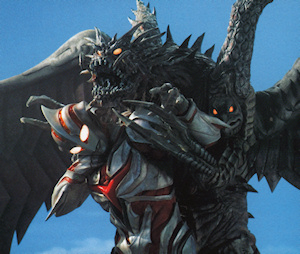 Ultraman and The One take to the skies for their final confrontation. ©2004 ULTRAMAN Movie Production Consortium
Ultraman and The One take to the skies for their final confrontation. ©2004 ULTRAMAN Movie Production ConsortiumSoon enough there are disturbing reports from the Shinjuku district in the heart of downtown Tokyo. A poisonous gas has been detected and the authorities suspect a terrorist threat. Maki knows better. The One has returned. Maki takes off in pursuit and Sara follows. They encounter a strange bedraggled figure in the subterranean waterways below the city. Sara recognizes him as Udo, her former lover. He pleads with her to tell him what has become of him. Sara, clutching a gun containing darts filled with a poison she has designed to kill him, wants to trust him. But she has seen too much already. In the previous battle, Udo in his monstrous form had tried to kill her. She fires. But the tears welling in her eyes cause her to miss. It’s just what the monster hoped for, he transforms back into the alien beast and captures Sara. Unbeknownst to him though, she has one dart left and fires it at point blank range into his heart. But instead of dying, the monster grows enraged and escapes again. Absorbing the bodies of thousands of sewer rats, The monster known as The One becomes even larger and more powerful. He emerges into the open, towering above even Tokyo’s mightiest skyscrapers! Maki transforms into his alien shape and the two do battle, threatening to crush the city to dust under their massive feet. Can Maki destroy The One while still keeping his human heart and soul? Or will the beast prevail?
ULTRAMAN
Ultraman, mysterious gigantic being from deep space, his origins unidentified, his intentions unknown, his powers seemingly unlimited. Unlike most American superheroes, Ultraman stands a towering 40 meters (140 feet) tall and does battle with massive monsters often even bigger than he is! Yet Ultraman has one fatal flaw. He can exist in Earth’s atmosphere for only three minutes at a time. In order to survive for long periods on Earth he must borrow the body of a human host and exist in a strange symbiosis of man and alien. What is Ultraman? Where does he come from? What is his true identity? What is his purpose here on Earth? Ultraman was created in 1966 by Eiji Tsuburaya. Before founding Tsuburaya Productions in 1963, Eiji Tsuburaya was already world famous as the special effects director of the classic Godzilla movies of the 1950’s and 60’s. Besides filming giant prehistoric monsters, outer space invasions and natural disasters, Eiji was known for his realistic recreations of wartime scenes, leading to his employment in Frank Sinatra’s war epic NONE BUT THE BRAVE. Eiji also directed effects in such non-science fiction films as THE THREE TREASURES starring Toshiro Mifune and worked on Akira Kurosawa’s THRONE OF BLOOD, as well as many others.
 Ultraman The Next saves a woman and her daughter from being crushed by a falling building. ©2004 ULTRAMAN Movie Production Consortium
Ultraman The Next saves a woman and her daughter from being crushed by a falling building. ©2004 ULTRAMAN Movie Production ConsortiumULTRAMAN became an unprecedented hit on Japanese television spawning seventeen sequel TV series and a string of hit theatrical features over the course of its four decade history. Ultraman has been seen in over 100 territories around the world and remains one of the top selling hero characters throughout Asia. Ultraman is a licensing bonanza which has spawned over 3,000 licensed products and character goods, from toys and action figures for the kids all the way to grown-up items like automobile accessories and gold club covers. Tsuburaya Productions also creates and organizes live-stage events featuring Ultraman and other Tsuburaya characters.
A BRIEF HISTORY OF ULTRAMAN
July 17, 1966 ULTRAMAN debuts, the first in a forty+ year run of programs featuring Ultraman and the other Ultra Heroes. July 22, 1967 ULTRAMAN: THE MOVIE debuts, the first in a long series of Ultraman theatrical features. Autumn 1967 ULTRAMAN debuts on US television. United Artists snapped up the syndication rights to the show even before it had finished its Japanese network run. ULTRAMAN continued to play in syndication in America until the mid-1980’s! October 1, 1967 ULTRA SEVEN debuts. Unlike the American custom of continuing a successful show for many seasons, the Japanese prefer to launch sequels to popular TV programs, slightly altering the format and adding new characters. ULTRA SEVEN is the first of the many sequels to ULTRAMAN. April 2, 1971 THE RETURN OF ULTRAMAN debuts on Japan’s TBS network. After a brief hiatus, this series begins a decade-long series of new Ultraman TV shows including ULTRAMAN ACE, ULTRAMAN TARO, ULTRAMAN LEO, and ULTRAMAN 80.
April 4, 1979 THE ULTRAMAN debuts. This is the very first all-animated Ultraman series. December 24, 1986 ULTRAMAN KIDS make their TV debut, an animated series aimed at the younger set. Autumn, 1987 ULTRAMAN: THE ADVENTURE BEGINS debuts on US television. This animated collaboration between Tsuburaya Productions and Hanna-Barbera marked the first Ultraman program to be co-produced in America. September 25, 1990 ULTRAMAN: TOWARDS THE FUTURE debuts in America. This 13 episode English language mini-series was filmed entirely on location in Australia with an international cast. March 9, 1996 ULTRAMAN ZEARTH debuts as a segment of the feature film THE WONDERFUL WORLD OF ULTRAMAN. After a hiatus, Ultraman returns to Japan’s motion picture screens on the franchise`s 30th anniversary. From 1996-2004, a new Ultraman theatrical feature was released every year.
September 7, 1996 ULTRAMAN TIGA debuts on Japan’s MBS network. This series marked a fresh beginning to the Ultraman saga featuring updated special effects and a whole new take on the familiar Ultraman mythology. A new series followed nearly every year with ULTRAMAN DYNA, ULTRAMAN GAIA, ULTRAMAN COSMOS, ULTRAMAN NEXUS, ULTRAMAN MAX and ULTRAMAN MEBIUS. December 18, 2004 ULTRAMAN: THE NEXT hits theater screens across Japan! September 16, 2006 After a short break, Ultraman returns to theaters in the 40th anniversary film ULTRAMAN MEBIUS & ULTRAMAN BROTHERS. October 6, 2007 ULTRASEVEN X debuts as the first late night, adult themed Ultraman series. December 1, 2007 Ultraman`s monstrous foes take center stage in their own hit series, ULTRA GALAXY: MEGA MONSTER BATTLE. The second season, ULTRA GALAXY: MEGA MONSTER BATTLE- NEO, debuted on December 20, 2008. September 13, 2008 The movie SUPERIOR ULTRAMAN 8 BROTHERS is released. It becomes the highest grossing film to that date in the Ultraman series. December 12, 2009 MEGA MONSTER BATTLE: ULTRA GALAXY, the first Ultraman movie produced by Tsuburaya Pro`s new owners the TYO Group, opens in Japan. Utilizing extensive computer graphics, this epic space adventure heralds a new era for Ultraman and Tsuburaya effects.
THE STAFF OF ULTRAMAN: THE NEXT
??? Kiyoshi Suzuki, Producer
Kiyoshi Suzuki graduated in 1964 from Nihon Daigaku University`s art college and entered Tsuburaya Productions the same year. He worked on the programs ULTRA Q (1966) and ULTRAMAN (1966) as an assistant cameraman and made his debut as director of photography in the latter half of the Ultraman television series. Later he worked for the Nihon Gendai Kikaku, Soeisha and Film Link companies as a director and producer. In 1988 he returned to Tsuburaya Productions where he currently works as a producer for the company`s Production Department. His major production credits include the television series ULTRAMAN, ULTRA SEVEN (1967) and ULTRAMAN TARO (1974) on which he was director of photography, and the feature films GAME KING (1985), LOVE THAT PERSON (1987) and THE WINNERS (Shorishatachi, 1992) which he produced. He has also served as producer for all of the Ultraman feature films made from 1996-2008. ???? Kazuya Konaka, Director Born August 2, 1963. A member of Directors Guild of Japan. Kazuya got his first eight millimeter camera while he was still in elementary school and used it to make a his first amateur films. In 1985 he graduated from Rikkyo University, faculty of law. That same year, the after receiving investments from the Bungeiza movie theater in Tokyo`s Ikebukuro district, he made his first film, THE LAND BEYOND THE STARRY SKY (Hoshi Zora no Mukou no Kuni). The film made its debut as Bungeiza Le Pilier`s New Year`s film in 1986 (traditionally Japan`s biggest season for movie openings) and was a record breaking hit. In 1992, along with his wife Akiko and his brother Chiaki, a well-known screenplay writer, Kazuya formed his own company called Koguma Kyodaisha. Along with the Pony Canyon and Takara, Koguma Kyodaisha produced the film LITTLE BEAR (Kuma-chan). Beginning in 1997 with the film ULTRAMAN ZEARTH 2 (Urutoraman Zeasu 2), Kazuya began a long association with the Ultraman film and television series, directing several installments for TV and the theatrical releases ULTRAMAN TIGA AND ULTRAMAN DYNA (Urutoraman Tiga & Urutoraman Daina: Hikari no Hoshi no Senshitachi, 1998) and ULTRAMAN GAIA: THE BATTLE IN HYPERSPACE (Urutoraman Tiga & Urutoraman Daina & Urutoraman Gaia Choujikuu-no Daikessen, 1999). In 2003 he made his debut as a director of animation, directing the animated TV series ASTRO BOY (Tetsuwan Atom). More recently, he directed episodes of ULTRAMAN NEXUS, MIRROR MAN: REFLEX (Miraaman Reflex, 2006), and the feature films ULTRAMAN MEBIUS & ULTRAMAN BROTHERS (Urutoraman Mebiusu & Urutora Kyoudai, 2006) and TOKYO GIRL (Tokyo Shojo, 2008). ???? Yuichi Kikuchi, Special Effects Director
Born in Iwate Prefecture, Japan, in 1970, Kikuchi graduated from the Tokyo Shashin Senmon Gakko (now Tokyo Visual Arts), with a degree in film and film art direction. Shortly after graduating Kikuchi became a freelance director. After working on several TV and movie productions, he joined Tsuburaya Productions and entered the world of special effects cinema. His special effects film debut was the theatrical feature ULTRAMAN ZEARTH (Urutoraman Zeasu, 1996). From then on Kikuchi`s association with special effects continued. He worked on the television series ULTRAMAN TIGA as well as its follow up shows ULTRAMAN DYNA and ULTRAMAN GAIA. He also participated in the creation of the feature film ULTRAMAN TIGA AND ULTRAMAN DYNA, as well as the movies GAMERA 3: REVENGE OF IRIS and WHITEOUT (2000), two of Japan`s most talked about special effects oriented films. It was through this work that he ended up at Toho company working on the film GODZILLA VS MEGAGUIRUS (Gojira X Megagirasu: Ji Shometsu Sakusen, 2000) as well as the following two Godzilla films. In 2002, Kikuchi was selected to direct the special effects for the film GODZILLA AGAINST MECHAGODZILLA (Gojira X Mekagojira, 2002), making his debut as a special effects director in one of the world`s most prestigious film series.
Since then he has worked on the Sunrise company`s full CGI series SD GUNDAM FORCE (2003). Then he was once again called by his old employers, Tsuburaya Productions, to direct special effects on their 2004 release ULTRAMAN: THE NEXT and episodes of ULTRAMAN NEXUS. ???? Tak Matsumoto/ Composer “Theme from Ultraman” and “Never Goodbye” Tak Matsumoto is known to millions all across Asia as the leader of the Japanese hard rock group B’z. Born in Osaka on March 27, 1961, Matsumoto founded B’z in 1988 with vocalist Koshi Inaba. Together the duo has racked up numerous chart hits throughout Asia. Matsumoto’s skills as a guitarist led him to become one of only five guitar players to be licensed by Gibson Guitars for a signature model version of their classic Les Paul guitar. The other artists were Jimmy Page (Led Zeppelin), Slash (Guns ‘n’ Roses), Joe Perry (Aerosmith) and Ace Frehley (Kiss). Good company, indeed! He recently put together the Tak Matsumoto Group featuring Eric Martin of Mr. Big on vocals and Jack Blades of Damn Yankees on bass. The group performs their hit song "Never Goodbye" over the closing credits of ULTRAMAN: THE NEXT.
THE ACTORS FROM ULTRAMAN: THE NEXT
 Tetsuya Bessho stars as Shunichi Maki, the human host of Ultraman the Next. ©2004 ULTRAMAN Movie Production Consortium
Tetsuya Bessho stars as Shunichi Maki, the human host of Ultraman the Next. ©2004 ULTRAMAN Movie Production Consortium???? Tetsuya Bessho Character Name: Shunichi Maki (Ultraman: The Next) Born in Shizuoka Japan August 31, 1965, Bessho’s hobbies include singing, piano and studying English. In 1992 he won the Japanese Academy Award for best actor in the category of newcomer and also starred in GODZILLA AND MOTHRA: THE BATTLE FOR EARTH (Gojira tai Mosura, 1992). His film credits include PARASITE EVE (1997) and 13 STEPS (13 Kaidan, 2003). He is also a stage actor, having appeared in the Japanese productions of LES MISERABLES (2003) and YOU`RE IN TOWN (2004). ???? Name: Kenya Osumi Character Name: Takafumi Udo (The One) Like Bessho, Osumi was also born in Shizuoka on October 26, 1965. An accomplished stage actor, he has appeared in the Japanese productions of SNOOPY!! THE MUSICAL (2001) and SATURDAY NIGHT FEVER (2003). He is an avid skier. ????? Name: Kyoko Toyama Character Name: Sara Mizuhara (Udo’s fiancée, the mysterious woman in black) Born in Tokyo on May 16, 1975, Ms. Toyama won the Japanese Academy Award for Best Actress (Newcomer) in 1994 and the Blue Ribbon Award for Best Actress that same year. As a comic actress she is well-known in Japan for her characters on the TV series LIFE OF A LAUCHING DOG (Warau Inu no Seikatsu), the Japanese equivalent of SATURDAY NIGHT LIVE. Her previous films include THE WEDDING PLANNER (2002) and MANHATTAN LOVE STORY (2003). She reprised the role of Sara Mizuhara in the TV series ULTRAMAN NEXUS.
Tsuburaya Productions Presents ULTRAMAN: THE NEXT
2004/ 97 minutes/ Color Japanese Theatrical Release: December 18, 2004 US Premiere: June 25, 2005
 Left to right: Tetsuya Bessho (Shinichi Maki), Kyoko Toyama (Sara Mizuhara) and Kenya Osumi (Takafumi Udo) at the Japanese premiere screening of ULTRAMAN: THE NEXT. ©2004 ULTRAMAN Movie Production Consortium
Left to right: Tetsuya Bessho (Shinichi Maki), Kyoko Toyama (Sara Mizuhara) and Kenya Osumi (Takafumi Udo) at the Japanese premiere screening of ULTRAMAN: THE NEXT. ©2004 ULTRAMAN Movie Production ConsortiumStarring Tetsuya Bessho as Shunichi Maki Kenya Osumi as Takafumi Udo Kyoko Toyama as Sara Mizuhara Nae Yuki as Yoko Maki Toshiya Nagasawa Masao Kusakari Ryouhei Hirota as Tsugumu Maki Directed by Kazuya Konaka Produced by Kiyoshi Suzuki Screenplay by Keiichi Hasegawa Director of Photography: Shinichi Ooka Special Effects by Yuichi Kikuchi Music by Tak Matsumoto (B’z) ©2004 ULTRAMAN Movie Production Consortium
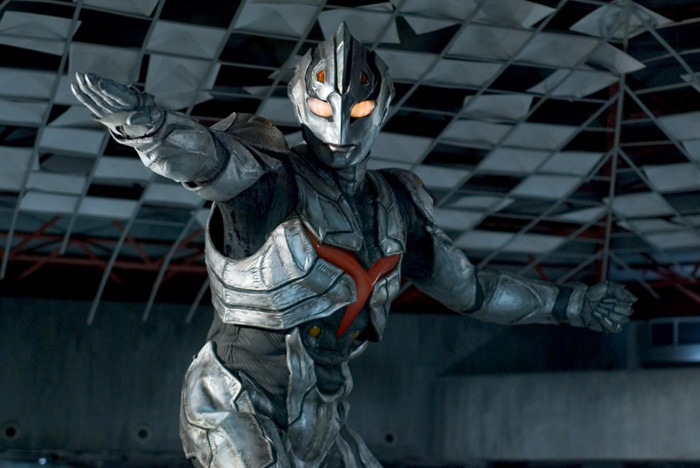 The initial incarnation of ULTRAMAN: THE NEXT prepares to do battle. Photo courtesy of Tsuburaya Productions. ©2004 ULTRAMAN Movie Production Consortium
The initial incarnation of ULTRAMAN: THE NEXT prepares to do battle. Photo courtesy of Tsuburaya Productions. ©2004 ULTRAMAN Movie Production ConsortiumULTRAMAN: THE NEXT FX INTERVIEWS
In 2004, some of the crew behind ULTRAMAN: THE NEXT spoke with Brad Warner about their work on the film...
COMMENTS FROM DESIGNER HIROSHI MARUYAMA
Hiroshi Maruyama has designed most of the Ultramen, kaiju, and mecha for Tsuburaya Productions since the earlier 1990s. He also designed the mecha for GODZILLA AGAINST MECHAGODZILLA (though not MG himself, as is sometimes reported). There`s a funny saying about him which is that he supposedly looks like Gaira, the Green Gargantua from WAR OF THE GARGANTUAS. In a manga about the making of GODZILLA AGAINST MECHAGODZILLA, he is even drawn as Gaira.
"Ultraman is a very simple design. The original version made by Tohl Narita is about as simple as you can get. When designing a new Ultraman character just about all you can do is add to that basic design. This, unfortunately, removes some of the simplicity which is a big part of the design`s charm. But it really can`t be helped. If you tried to remove anything form that design what would you have? It would look like Pepsi Man!" "But there are some aspects of Ultraman`s design that have to be protected in order to make him Ultraman. You can`t remove that crest on his head, for example, or else he looks like one of the so-called `grey` aliens like in X Files. And you can`t give him a nose -- though one of our earlier Ultraman characters, Ultraman 80, did have a nose, and it made him look much less like Ultraman. The nose and the upper lip are kind of fused together. That`s the way I envision it, anyway. Also you need to retain the red lines on the silver body." "Ultraman The Next`s first appearance in the movie is made to look deliberately incomplete. The director [Kazuya Konaka] asked me to design what he called a `mutant Ultraman`. In hise first incarnation, the face and body of The Next were molded to look almost exactly like the clay demo model I built, meaning that all of the little dips and imperfections were retained. But the Bible says that man was originally made out of clay, right?" "The design is deliberately asymmetrical. If you make it perfectly symmetrical Ultraman would look like a robot, or like some kind of manufactured item. But he is supposed to be a living being." "As you know, Ultraman traditionally has a warning light on his chest, called the Color Timer. When his energy level drops it changes from blue to red and begins flashing. This time we made that light a more organic looking design. And it is inside his body, below the skin, rather than outside as it had been previously. It`s like you`re looking through a window into his body."
 In 2005, Hiroshi Maruyama was a special guest for the San Francisco screening of ULTRAMAN: THE NEXT. Photo courtesy of Bay Area Film Events. ©2004 ULTRAMAN Movie Production Consortium
In 2005, Hiroshi Maruyama was a special guest for the San Francisco screening of ULTRAMAN: THE NEXT. Photo courtesy of Bay Area Film Events. ©2004 ULTRAMAN Movie Production Consortium"I had originally wanted to give him a kind of transparent skin. I thought it would be cool if you could see glowing streams of red energy, like blood vessels, or like lava flows, underneath the surface. A little bit of that sense was retained in the final design. But they decided my original idea might be a bit too shocking." "I thought about what might happen if a human being actually did suddenly become that large, the way Maki does when he changes into Ultraman. My original idea was to have his body actually change shape. But the director thought that would be a little too much like the Japanese animated character Devilman so we dropped it." "When Maki transforms into Ultraman, I had this idea that the rapid cell division taking place would generate intense heat. His whole body would become as hot as burning lava and melt anything nearby. Again, that image was looked upon as a bit too intense. You have to remember, the main audience for Ultraman is still children even though this movie is also aimed at adults. But when you watch the final film, you`ll see that they kept a bit of that theme of him glowing as he transformed. What you see in the final film is that there is supposed to be a glowing ball of white hot light forming inside of his body. It`s a little hard to tell. But that`s the idea." "I wanted this to be a film adults could enjoy. I think the whole staff felt that way about it."
COMMENTS FROM SPECIAL EFFECTS DIRECTOR YUICHI KIKUCHI
"In Japan, Ultraman is a very orthodox thing. Every movie follows a familiar pattern. And that`s OK. That`s the whole point of it for Japanese audiences. Still, you need to find new ways of reinventing that one pattern each time."
"In Western heroes, the face is open, we can see it. Even in a character like Batman, we can still see part of the face. But Japanese heroes have what I call a `closed face.` It`s completely covered so you can`t see any expression at all." "The reason we continue to use costumes instead of going for full CG like they do in America is because the first Japanese giant monster, Godzilla, was done that way. It`s a kind of part of Japanese culture." "I always think in terms of physics. What would it really be like if a gigantic creature appeared in a city like Tokyo? Of course, if you really study it, a creature as big as Ultraman would be too heavy to support its own weight. So you need to ignore real physics as well, to an extent." "The set for Shinjuku where the main battle takes place would have been too big to actually build. So we used a lot of compositing, putting our costumed actors into real backgrounds."









